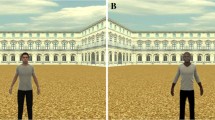Abstract
Previous research suggests that the concept of control is central to understanding spatial regulation. Similarly, control motivation appears to underlie the individual difference variable of Type A behavior. Based on this commonality it was hypothesized that Type A behavior would mediate spatial claims in response to situational threat. Results confirmed this hypothesis. Type A's claimed larger spaces overall, and more space in front of the body in response to threat, than Type B's. Differential results for size and shape of personal space suggest the multidimensional nature of spatial regulation.
Similar content being viewed by others
References
Alexander, C.N., & Scriven, G.D. Role-playing: an essential component of experimentation.Personality and Social Psychology Bulletin 1977,3 455–466.
Altman, I.The environment and social behavior: privacy, personal space, territory, crowding. Monterey, Calif.: Brooks/Cole, 1975.
Aronson, E., & Carlsmith, J. Experimentation in social psychology. In G. Lindzey & E. Aronson (Eds.),The handbook of social psychology (Vol. 2). Reading, MA: Addison-Wesley, 1968.
Baum, A., Aiello, J.R., & Calesnick, L.E. Crowding and personal control: social density and the development of learned helplessness.Journal of Personality and Social Psychology 1978,36 1000–1011.
Brehm, J.W.Responses to loss of freedom: a theory of psychological reactance. Morristown, NJ: General Learning Press, 1972.
Brunson, B.I., & Matthews, K.A. The Type A coronary-prone behavior pattern and reactions to uncontrollable stress: an analysis of performance strategies, affect, and attributions during failure.Journal of Personality and Social Psychology 1981,40 906–918.
Carver, C.S. Perceived coercion, resistance to persuasion, and the Type A behavior pattern.Journal of Research in Personality 1980,14 467–481.
Cozby, P.C. Effects of density, activity, and personality on environmental preferences.Journal of Research in Personality 1973,7 45–60.
Cronbach, L.J., & Furby, L. How should we measure “change” — or should we?Psychological Bulletin 1970,74 68–80.
Dembroski, T.M., Weiss, S.M., Shields, J.L., Haynes, S.G., & Feinleib, M. (Eds.),Coronaryprone behavior. New York: Springer-Verlag, 1978.
Dooley, B.B. Crowding stress: the effects of social density of men with “close” and “far” personal space. Reported in C. Greenberg, Crowding and environmental control. In M.R. Gurkaynak & W.A. LeCompte (Eds.),Human consequences of crowding. New York: Plenum, 1978.
Dosey, M.A., & Meisels, M. Personal space and self-protection.Journal of Personality and Social Psychology 1969,11 93–97.
Edney, J.J. Territoriality and control: a field experiment.Journal of Personality and Social Psychology 1975,31 1108–1115.
Edney, J.J., Walker, C.A., & Jordan, N.L. Is there reactance in personal space?Journal of Social Psychology 1976,100 207–217.
Freedman, J.L. Role playing: Psychology by consensus.Journal of Personality and Social Psychology 1968,13 107–114.
Geller, D.M. Involvement in role-playing simulations: a demonstration with studies on obedience.Journal of Personality and Social Psychology 1978,36 219–235.
Glass, D.C.Behavior patterns, stress, and coronary disease. Hillsdale, NJ: Erlbaum, 1977.
Greenberg, C.I. Crowding and environmental control. In M.R. Grukaynak & W.D. LeCompte (Eds.),Human consequences of crowding. New York: Plenum, 1978.
Greenberg, C.I., Strube, M.J., & Myers, R. A multitrait-multimethod investigation of interpersonal distance.Journal of Nonverbal Behavior 1980,5 104–114.
Hayduk, L.A. Personal space: an evaluative and orienting overview.Psychological Bulletin 1978,85 117–134.
Hayduk, L.A. The permeability of personal space.Canadian Journal of Behavioral Science 1981,13 274–287.
Hendrick, C. Role-taking, role-playing, and the laboratory experiment.Personality and Social Psychology Bulletin 1977,3 467–478.
Horowitz, M.J. Spatial behavior and psychopathology.Journal of Nervous and Mental Disease 1968,146 24–35.
Horowitz, M.J., Duff, D.F., & Stratton, I.O. Body-buffer zone.Archives of General Psychiatry 1964, 11, 651–656.
Kirk, R.E.Experimental design: Procedures for the behavioral sciences. Belmont, CA: Brooks/Cole, 1968.
Krantz, D.S., Glass, D.C., & Snyder, M.L. Helplessness, stress level, and the coronary-prone behavior pattern.Journal of Experimental Social Psychology 1974,10 284–300.
Matthews, K.A. Psychological perspectives on the Type A behavior pattern.Psychological Bulletin 1982,91 293–323.
Milgram, S. Behavioral study of obedience.Journal of Abnormal and Social Psychology 1963,67 371–378.
Miller, A. Role playing: An alternative to deception? A review of the evidence.American Psychologist 1972,27 623–636.
Mixon, D. Behavior analysis treating subjects as actors rather than organism.Journal for the Theory of Social Behavior 1971,1 19–31.
Mixon, D. Instead of deception.Journal for the Theory of Social Behavior 1972,2 145–177.
Mixon, D. Why pretend to deceive?Personality and Social Psychology Bulletin 1977,3 647–653.
Orne, M. On the social psychology of the psychological experiment: with particular reference to demand characteristics and their implications.American Psychologist 1962,17 776–783.
Proshansky, H.M., Ittelson, W.H., & Rivlin, L.G. Freedom of choice and behavior in a physical setting. In H. M. Proshansky, W. H. Ittelson, & L.G. Riylin (Eds.),Environmental psychology: people and their physical settings. New York: Holt, Rinehart, & Winston, 1970.
Rhodewalt, F., & Comer, R. Coronary-prone behavior: the attractiveness of an eliminated choice.Personality and Social Psychology Bulletin 1982,8 152–158.
Rhodewalt, F., & Davison, J., Jr. Reactance and the coronary-prone behavior pattern: the role of self-attribution in response to reduced behavioral freedom.Journal of Personality and Social Psychology, in press.
Rodin, J., Solomon, S.K., & Metcalf, J. Role of control in mediating perceptions of density.Journal of Personality and Social Psychology 1978,36 988–999.
Schmidt, D.E., & Keating, J.P. Human crowding and personal control: an integration of research.Psychological Bulletin 1979,86 680–700.
Seligman, M.E.P.Helplessness: On depression, development, and death. San Francisco: Freeman, 1975.
Severy, L.J., Forsyth, D.R., & Wagner, P.J. A multimethod assessment of personal space development in female and male, black and white, children.Journal of Nonverbal Behavior 1980,4 68–86.
Stokols, D. A social-psychological model of human crowding phenomena.Journal of the American Institute of Planners 1972,38 72–83.
Strube, M.J., & Werner, C. Interpersonal distance and personal space: a conceptual and methodological note.Journal of Nonverbal Behavior 1982,6 163–170.
Author information
Authors and Affiliations
Additional information
The authors thank Irwin Altman, Martin Chemers, and Frederick Rhodewalt for their helpful comments on an earlier version of this manuscript. We are grateful to Carol Dye and Craig Bunker for serving as confederates.
Rights and permissions
About this article
Cite this article
Strube, M.J., Werner, C. Personal space claims as a function of interpersonal threat: The mediating role of need for control. J Nonverbal Behav 8, 195–209 (1984). https://doi.org/10.1007/BF00987291
Issue Date:
DOI: https://doi.org/10.1007/BF00987291




